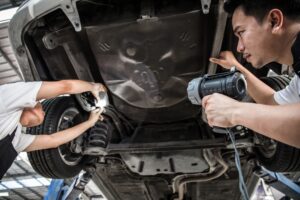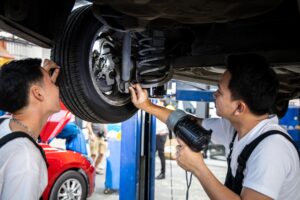A suspension system is an essential part of a vehicle. The system works hard to ensure that your driving is comfortable by absorbing and reducing shock from the road, so you don’t feel every bump. It provides traction by keeping the wheels on the ground as much as possible.

The main parts of the suspension system include the shock absorbers, springs, control arms, struts, etc. So what happens when there are car suspension problems?
Sometimes it’s tricky to diagnose car suspension problems. You may notice some signs but can easily be mistaken for something else. Identifying the warning signs of suspension system problems can help you find the difference between needing major or minor repairs.
Here are the most common car suspension problems and the symptoms to look out for:
-
Get to feel every bump.
As you may already know, the suspension system plays a vital role in easing out the bumps on the road. The most basic car suspension problem is that it makes you feel the braking and turns far rougher. If you start to feel the jerk on every pothole, it’s evident that there is a problem with your struts or shock absorbers.

An easy check is the bounce test. Put your total weight down on your car’s bonnet. Release and calculate the number of times the vehicle bounces. If it reflects more than three times, your shock absorbers or struts need a quick check.
-
Drifting during the turns
Drifting is a sign that the shocks no longer work as they should. Your car cannot stay steady, and you sense it every time you turn.
-
Uneven tire treads
Uneven tire threads are widespread when it comes to a car suspension problem. A tread is that part of the tire that comes in contact with the road’s surface. Therefore, your tire treads should remain even. However, when suspension doesn’t keep them, you notice one side has reduced treads.
-
One corner sits low.
If you see that one corner of your car appears to be a lot lower than the others, there’s a good possibility you have a damaged spring. While driving, you may also notice a clunking noise over bumps or deep potholes.

To check this, ensure you have correct and equally inflated tiers. If one corner still seems to droop, push your whole weight down on the car’s boot and listen to how the suspension reacts. A squealing or creaking sound will confirm that you must take your vehicle to a mechanic.
-
Diving, squatting and rolling.
Does your car:

- Nose dive forward or lean forward when you brake?
- Rolls to the side or tilts from side to side when you corner?
- Squats backward or leans back when you accelerate?
If Yes, you have an issue with the shock absorbers or struts. If there is trouble with your shock absorbers, you should take your car to a repair person as soon as possible, as it is risky to drive with broken shock absorbers or struts.
-
Difficulty in steering
When your steering becomes difficult to rotate, especially when driving at low speeds, there may be an issue with your steering or suspension system. It can either be a low level of power steering fluid, a leaking power steering rack, a faulty power steering pump, or worn control arm bushings.
It is dangerous to drive when your steering isn’t working correctly. It is better to get it inspected as soon as possible.
What is the Average Repair Cost of a Car Suspension?
There are plenty of things to consider regarding a car suspension repair cost. From the average price point to how prices vary by vehicle, it’s essential to be familiar with every part of the fees that come with car suspension problems to make the best decision for your vehicle’s future.
As soon as a problem emerges, you want to take your vehicle to a professional immediately. A car suspension problem is not affordable or cheap. It can cost approximately $1,000-$5,000 to fix a car suspension system. You may find one component only for a few hundred dollars, but mostly car suspension systems come with a package deal. One piece that needs replacing means a dozen others will follow. Numerous factors can affect the price, from the parts that need repairing to the type of car.
Here are some main costs to consider-
- Shock absorber replacement: $200-$1,500
- Coil spring replacement: $550-$700
- Strut replacement: $50-$900
- Wheel alignment: $20-$400
Most car manuals propose the average life of a suspension system is around 70,000 miles, depending on the driver and the roads.
What to expect after a repair?
Although there are ways to repair the suspension system, it’s not worth the time and money put into it. Repair does not give you any future guarantee of a permanent fix.
The easiest way to sell a car with a suspension problem is to sell it to Sellyouroldcarnow.com and get a guaranteed offer.
Contact us now! To get your vehicle picked up and get cash instantly.

